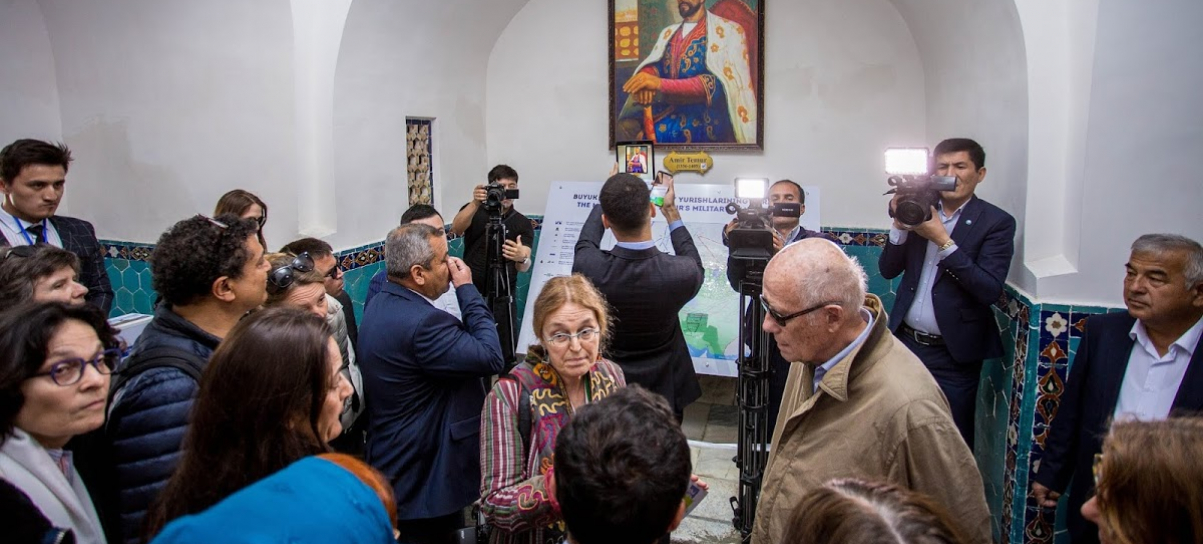The first Smart-Museum in Central Asia opened in Samarkand
The first Smart Museum in Central Asia opened in the mausoleum of Amir Temur in Samarkand. Currently, the audio guide is available for ten exhibits in five languages - Russian, Uzbek, English, French and Korean.
The director of SmartChain LLC, Bobur Rakhimov, spoke about the first experience of creating a Smart Museum, its purpose and significance for the development of tourism. From his words it became clear that now visitors have the opportunity to get additional information about the exhibit and / or the mausoleum with modern interactive methods. Technical capabilities allow the visitor to be immersed in the atmosphere of long-gone years, places and events, to recreate historical scenes and images that clearly highlight historical and cultural traditions.
For visitors, the possibility is realized when using a smartphone (headphones are given to each visitor) to use the audio guide for the main exhibits. Directing the camera of the smartphone to the object of the exhibition, marked with an icon, the visitor is provided with a story about the object of art. Moving between the objects of the exhibition in the specified order, the visitor receives a full-fledged tour in a rhythm convenient for him. At the same time he will be able to listen to the information provided. Also, video fragments from historical chronicles were created to convey to the visitor a historical atmosphere.
Opportunities are not limited to excursion content. For example, an interactive Uzbekistan exposition consisting of four smart-pictures and eight 3D racks has been created on the territory of the mausoleum. The visitor receives interactive information about the historical regions of our country.
The first Smart-Museum in Central Asia opened in Samarkand
The technology of augmented reality on the NazzAR platform is a system of user interaction with objects of the surrounding world, using a smartphone. The user receives additional interactive content in the form of audio, video, 3D-scenes and objects. To get started, the user needs to install the NazzAR application available on Android and iOS devices on his smartphone.
B. Rakhimov noted that this project was implemented on the instructions of President Shavkat Mirziyoyev. During his visit to Samarkand in January of this year, when the system was presented to the head of state, he proposed to introduce it in all major historical monuments of the country. “Here is the first result. The implementation of our project in museums and monuments will allow recreating historical scenes of the past, “revitalize” a static image, convey the “spirit of the times” and immerse the visitor into the world of exposition. Using the NazzAR solution, the visitor is given the opportunity not only to hear about the exhibit or the exhibition, but also to see the history, ”said B. Rakhimov.
The first Smart-Museum in Central Asia opened in Samarkand
The presentation of the Smart Museum took place the other day while visiting its members of the Association for the Study of the Culture and Art of the Temurids from France. According to the interlocutor, the guests, who were headed by the President of the Association, the famous historian Frederic-Bopertuis Bressan, highly appreciated the possibilities of the technology of augmented reality.
The first Smart-Museum in Central Asia opened in Samarkand
Speaking about other possibilities of his offspring, B. Rakhimov stressed that immersion in virtual reality will begin at the entrance to Amir Temur’s crypt. Visitors will wear virtual reality glasses in Ziyoratkhan. Thus, the entrance to the crypt with the help of modern technology will open to the visitor an exciting scene, he will be able to see the crypt itself in a 360-degree view.
At the same time, for the convenience of visitors, an interactive map of the complex has been created, which, unlike a regular map, has interactive features. In particular, when you hover the smartphone on separate sections of the map, a 3D model of sights appears on the smartphone screen. Thus, the map is integrated into the overall solution and becomes part of an amazing journey through the museum. Following the prepared routes on the map, the visitor approaches the perception of the museum’s exhibits more holistically.
B. Rakhimov noted that interactive souvenir cards are being created to extend the visitor’s journey. By purchasing a set of souvenir cards, a visitor can later reuse video, audio, and 3D content, share impressions with friends and acquaintances. The use of such cards allows you to draw attention to the museum, its exhibits and exhibitions, as well as expand its audience.
We recommend to see more:
Follow us on
Sign up for our newsletters
Find our latest discounted tours, updated itineraries and latest news about the region



